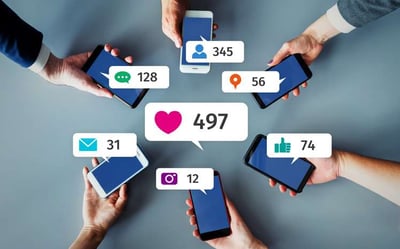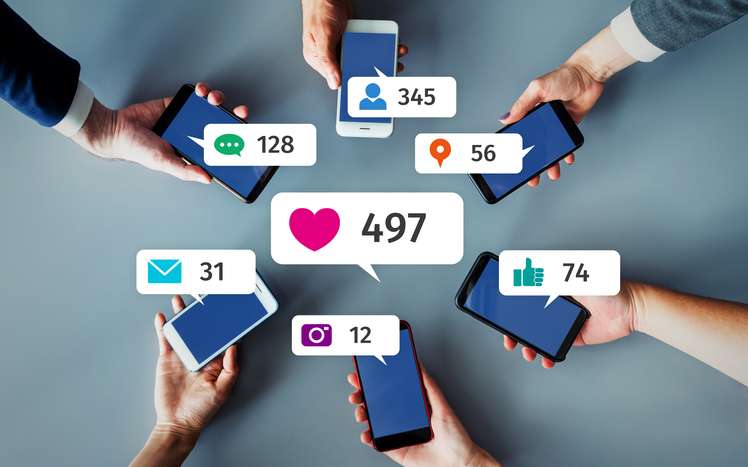Get Beyond "Likes": How to Update Your Social Media Marketing Strategy

For organizations of any size, social media is the most influential channel for sharing information and influencing opinions.
- 54% of social browsers use social media to research products and services.
- 71% of consumers who've had a good experience on a brand’s social media channels will recommend the brand to others.
Social media is critical to your strategy no matter what age group you want to reach. The Pew Research Center has reported how many Americans in each age group use social media regularly:
- 82% of 32–40‑year‑olds
- 69% of 50–64‑year‑olds
- 40% of those 65 and older
As social media has become part of daily life, people have come to prioritize and pay attention to posts that stand out because they seem to speak to them personally. There's nothing wrong with scheduling posts that draw users to content on your website that will be helpful to them. But a company that posts only automated posts isn't using the full potential of social platforms, and it will miss out on the opportunity to build relationships with prospective clients.
People are hungry for the human side of social media.
Establishing a social media presence
Social media is a key component of any successful nonprofit marketing plan. These are the four key steps to getting started—or correcting an inconsistent social media presence.
1. Identify your audience.
Before you even think about posting a tweet, video, or Facebook post, understand your social media audience. What types of people are going to be paying attention to your industry or cause online?
Consider one of your social networks from your audience's perspective. Would you follow your organization's account? If so, why? What does this page do that you would find interesting, relevant, or meaningful?
This process is made simpler if you have already created buyer personas, fictional representatives of your ideal audience.
2. Make your profiles consistent.
From Twitter and Facebook to LinkedIn and YouTube, every social media account should look consistent in terms of design and messaging.
While you don't need to have the same banner image for each profile, they should maintain the same color palette, style, and message.
- Stick to one tagline (if any) throughout social profiles.
- Keep a consistent tone. Is your brand messaging heartfelt? Funny? Informational?
- Consider using your logo as the profile image across all social channels.
3. Use a social media tool.
If you’re still bouncing from account to account to publish social messages, there's a better way. With a variety of social media tools out there, your job can be so much easier. Marketing automation software makes it possible to tie your contacts’ social media engagement to their entire buyer’s/advocate’s journey, all the way to becoming a customer or donor.
Using tools like HootSuite or Buffer, you can schedule social content across all of your channels weeks ahead of time. If you have a HubSpot subscription, you can get detailed analytics along with social media scheduling and monitoring.
With all these tools readily available to you, your job becomes far more streamlined. You still need to monitor your social media and determine the exact science of posting (times, hashtags, types of content, etc.), but having the right tools for the job makes that a lot easier.
4. Partner up.
As much as social media tools are making the process easier and more efficient, building a relevant social network can still be quite difficult. It takes a lot of time and research to find and create compelling content. And analyzing the data to provide meaningful insight often requires a pair of expert eyes. If your in‑house team doesn’t have the bandwidth or background to keep up with social media, consider getting help from an outside partner.
14 Tips to Convert “Likes” Into Something More
Once you’ve established a consistent, meaningful presence across your social media channels, it’s time to turn your followers into clients, members, or donors. Here's how:
- If someone uses your social media account to complain, give them the same amount of time and attention you’d give them if they came to you in person.
- Get to know your followers, their likes, and what they’re talking about. It’s a good time to start using buyer personas if you haven’t already.
- Be human. Don’t come across as a robot.
- Don’t be afraid to appeal to people’s emotions.
- Carry your brand identity over to your social media. Inject as much of your brand personality into your social media as you can. If you’re a fun brand, have a humorous approach to your social media. If you’re a nurturing brand, show you care.
- Give special discounts or offers to your social media followers. It’ll foster goodwill and increase sales/donations, and they’ll likely tell their friends about it.
- Share images and stories from around your office (or #workfromhome environments!). This provides your followers with more insight into who you are as an organization.
- Ask questions of your followers, and give genuine responses if they ask you something. Conversations are a two‑way street.
- Focus on quality over quantity. A small number of highly involved, loyal followers can be more important than having thousands of followers who tune you out. The same goes for dialogue created through social media.
- Don’t be so focused on the brand that you ignore what’s happening in the rest of the world. Create a discussion with your followers about current events and happenings that are relevant to you and your industry.
- Get permission from current customers and donors to use their recommendations and testimonials in your social media marketing.
- Use images on all your social media channels—not just Instagram! Photos and graphics grab fans’ attention and increase your reach.
- Link back to your website with offers they can’t refuse. Helpful ebooks, webinars, and infographics will attract fans in a win‑win scenario.
- Encourage people at your organization to interact with the brand’s social media profiles. They can tag the brand when they share interesting information about themselves and their work.
Bonus LinkedIn tip: Use Showcase Pages! These are a great way to highlight a particular product or service on your organization’s page.
It’s important to consider the amount of work it will take to maintain each Showcase Page when planning these pages because your LinkedIn admin needs to post fresh updates to each Showcase Page regularly. Otherwise, it will be difficult for these pages to attract and retain followers. The maximum number of Showcase Pages a company can have is 10.
Social media is an important part of nonprofit marketing plan, and as such, it’s crucial that organizations use it to:
- engage followers,
- create a dialogue,
- build relationships,
- and create a community around your brand.
Just as social media engagement is never over, neither should your social media strategy ever be considered "done." Use the strategies and tips above to evaluate your social media marketing strategy every year to make sure it's working for you and those you want to reach.




